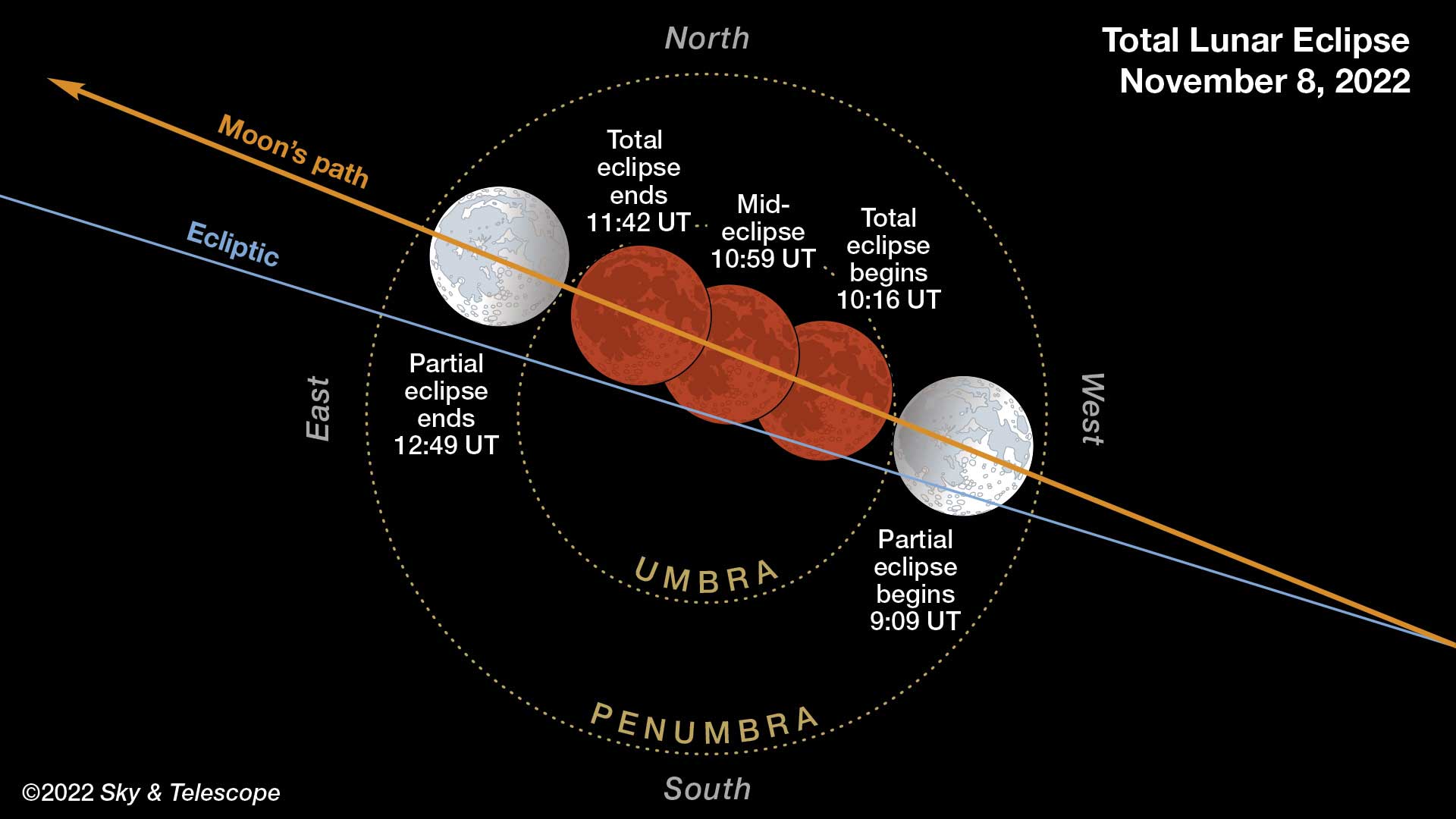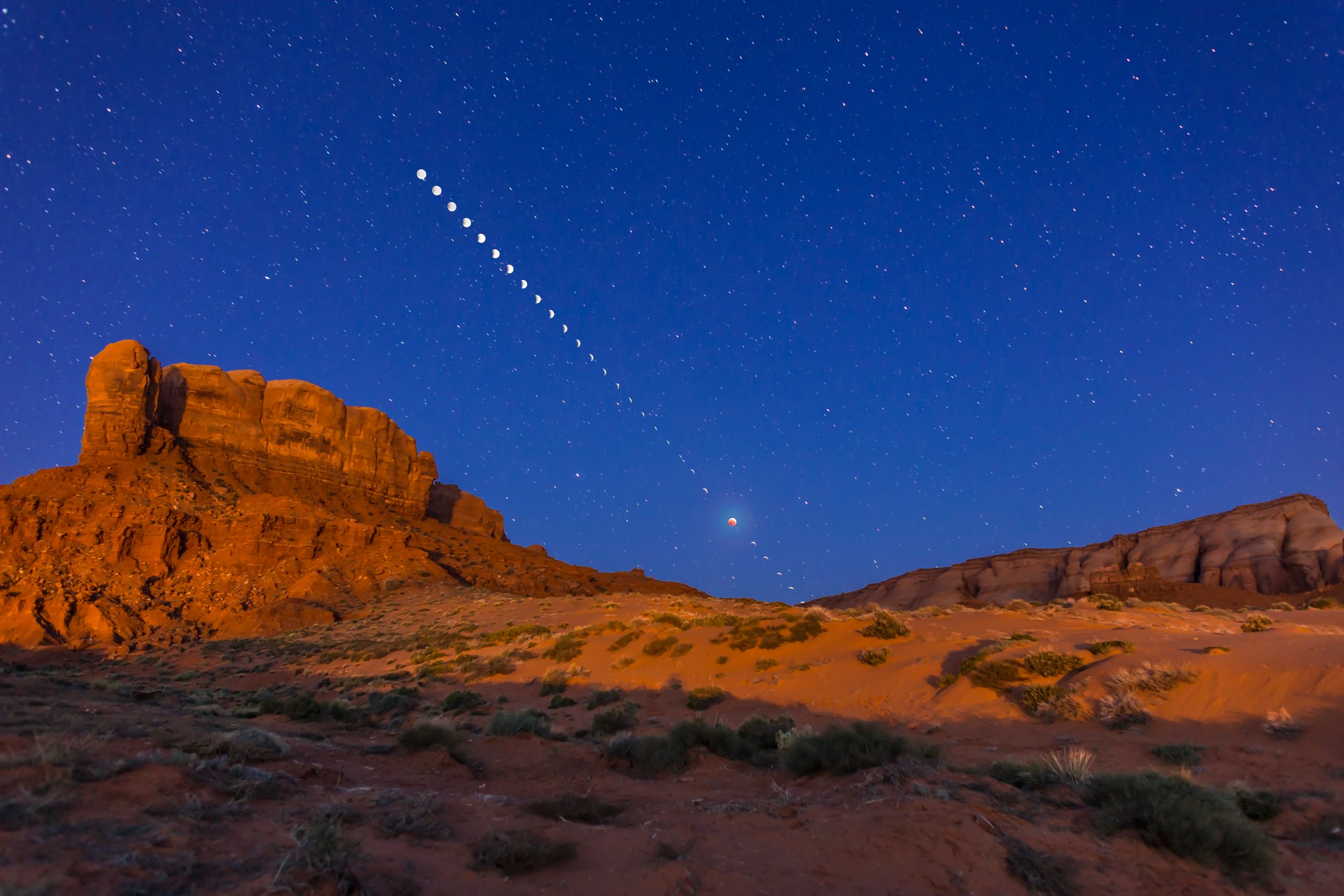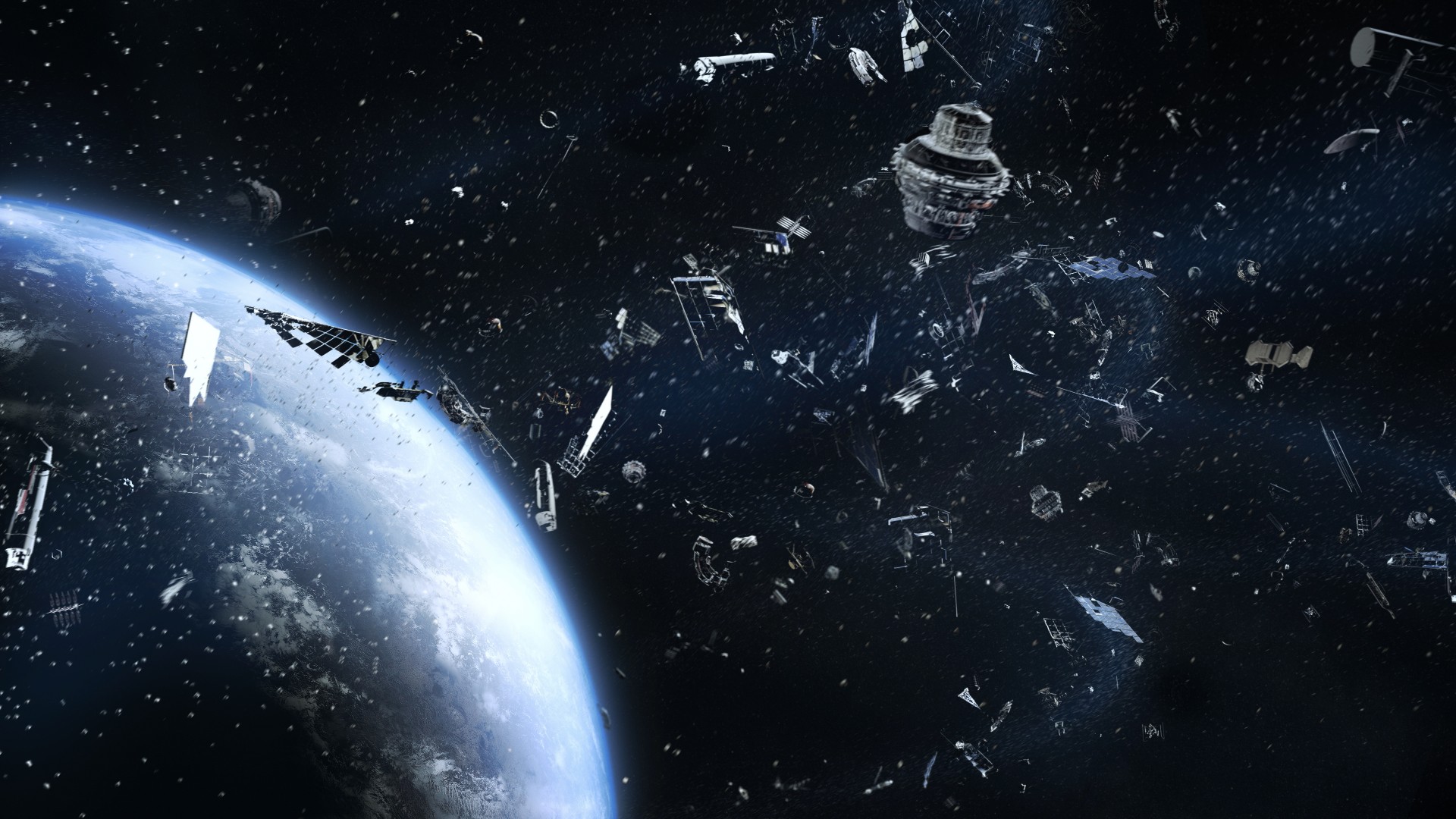Blood Moon 2022 explained: Here are the phases of our last total lunar eclipse for 3 years
Total eclipses of the moon are the most colorful of all astronomical phenomena.
Each lunar eclipse is unique, with its brightness and coloration determined by a range of factors, such as the geometry of the eclipse and the large-scale meteorological conditions on Earth. When the moon is entering, and later emerging from, Earth's shadow, secondary phenomena may be overlooked.
To help prepare for the upcoming Election Day total lunar eclipse of November 8, Space.com's Joe Rao — a veteran of 19 total lunar eclipses — has prepared a chronology of the different phases, including some of the things you might see. However, you may not glimpse everything mentioned here, because no two eclipses are exactly the same.
But many of these phenomena will indeed be visible, and observers who know what to look for will have a better chance of seeing the various stages. If the eclipsed moon is below the horizon in your location, or if bright lights or cloudy skies impede your view, you can watch the total lunar eclipse on Space.com for free, courtesy of several webcasts from observatories across the United States starting at 3 a.m. EST (0800 GMT).
Related: How to watch the Blood Moon lunar eclipse on Nov. 8 online, the last until 2025

Joe Rao is Space.com's skywatching columnist, as well as a veteran meteorologist and eclipse chaser who also serves as an instructor and guest lecturer at New York's Hayden Planetarium. He writes about astronomy for Natural History magazine, the Farmers' Almanac and other publications. Joe is an 8-time Emmy-nominated meteorologist who served the Putnam Valley region of New York for over 21 years. You can find him on Twitter and YouTube tracking lunar and solar eclipses, meteor showers and more. To find out Joe's latest project, visit him on Twitter.
The November full moon is traditionally known as the Beaver Full Moon.The native Americans of what are now the northern and eastern United States kept track of the seasons by distinctive names given to each recurring full moon, these names being applied to the entire month in which it occurred. In November it was time to set beaver traps before the swamps freeze to ensure a supply of warm winter furs.
In the timetable below, local circumstances are provided for seven different time zones. All times are for a.m. on Nov. 8, except when in italics, which corresponds to p.m. on Nov. 7. When dashes are provided, it means that the moon has not yet risen above the horizon.
Breaking space news, the latest updates on rocket launches, skywatching events and more!
| Stage | AST | EST | CST | MST | PST | AKST | HST |
|---|---|---|---|---|---|---|---|
| The moon enters the penumbral shadow | 4:01 | 3:01 | 2:01 | 1:01 | 12:01 | 11:01 | 10:01 |
| 2) Earth's penumbral shadow appears | 4:49 | 3:49 | 2:49 | 1:49 | 12:49 | 11:49 | 10:49 |
| 3) The moon enters Earth's umbral shadow | 5:09 | 4:09 | 3:09 | 2:09 | 1:09 | 12:09 | 11:09 |
| 4) The moon is 75% covered | 5:59 | 4:59 | 3:59 | 2:59 | 1:59 | 12:59 | 11:59 |
| 5) Less than five minutes to totality | 6:11 | 5:11 | 4:11 | 3:11 | 2:11 | 1:11 | 12:11 |
| 6) Total eclipse begins | 6:16 | 5:16 | 4:16 | 3:16 | 2:16 | 1:16 | 12:16 |
| 7) Middle of totality | — | 5:59 | 4:59 | 3:59 | 2:59 | 1:59 | 12:59 |
| 8) Total eclipse ends | — | 6:42 | 5:42 | 4:42 | 3:42 | 2:42 | 1:42 |
| 9) The moon is 75% covered | — | — | 5:59 | 4:59 | 3:59 | 2:59 | 1:59 |
| 10) Moon leaves umbra | — | — | — | 5:49 | 4:59 | 3:59 | 2:59 |
| 11) Penumbral shadow fades away | — | — | — | 6:09 | 5:09 | 4:09 | 3:09 |
| 12) Moon leaves penumbra | — | — | — | — | 6:58 | 5:58 | 4:58 |
Here's a breakdown of the stages of the total lunar eclipse and what you might see during each one:
1) The moon enters the penumbral shadow
The shadow cone of the Earth has two parts: a dark, inner umbra, surrounded by a lighter penumbra. The penumbra is the pale outer portion of Earth's shadow. Although the eclipse begins officially at this moment, you won't see anything unusual happening to the moon yet. Earth's penumbral shadow is so faint that it remains invisible until the moon is deeply immersed in it, when the penumbra has reached roughly 70% across the moon's disk. For about the next 40 minutes, the full moon will continue to appear to shine normally, but with each passing minute, it is progressing ever deeper into Earth's outer shadow.
2) Earth's penumbral shadow appears
Now, the moon has progressed far enough into the penumbra that it should be evident on the moon's disk. Start looking for a very subtle light shading to appear on the moon's upper left portion. This will become increasingly evident as the minutes pass, with the shading appearing to spread and deepen. Just before the moon begins to enter Earth's dark umbral shadow, the penumbra should appear as an obvious smudge or tarnishing of the moon's upper left portion.
3) The moon enters Earth's umbral shadow
The moon now begins to cross into Earth's dark central shadow, called the umbra. A small, dark scallop begins to appear on the moon's upper-left (northeastern) limb. The partial phases of the eclipse begin; the pace quickens, and the change is dramatic. The umbra is much darker than the penumbra and fairly sharp-edged. As the minutes pass, the dark shadow appears to slowly creep across the moon's face. At first, the moon's limb may seem to vanish completely inside the umbra. But much later, as it moves in deeper, you'll probably notice the moon glowing dimly orange, red or brown. Also notice that the edge of Earth's shadow projected on the moon is curved — visible evidence that Earth is a sphere (or, more precisely, an oblate spheroid), as deduced by Aristotle from lunar eclipses he observed in the fourth century B.C. It's almost as if a dimmer switch were slowly being turned down on the surrounding landscape and deep shadows of a brilliant moonlit night were beginning to fade away.
Across the western U.S. and Canada, the moon will already be partially immersed in the umbra. The low, partially eclipsed moon in deep blue twilight should offer a wide variety of interesting scenic possibilities for both artists and astrophotographers.
4) The moon is 75% covered
With three-quarters of the moon's disk now eclipsed, the part of it that is immersed in shadow should begin to light up very faintly, similar to a piece of iron heated to the point where it just begins to glow. It now becomes obvious that the umbral shadow is not complete darkness.
In binoculars or a telescope, the outer portion is usually light enough to reveal lunar seas and craters. But the central part is much darker, and sometimes, no surface features are recognizable. Colors in the umbra vary greatly from one eclipse to the next; reds and grays usually predominate, but sometimes, there are browns, blues and other tints.
5) Less than five minutes to totality
Several minutes before (and after) totality, the contrast between the remaining pale-yellow sliver and the ruddy-brown coloration spread over the rest of the moon's disk may produce a beautiful phenomenon sometimes called the Japanese lantern effect, a term first coined by astrophotographer Peter A. Leavens in the 1950s.
6) Total eclipse begins
When the last of the moon enters the umbra, the total eclipse begins. How the moon will appear during totality is not known. During some eclipses, it appears such a dark gray or black that the moon nearly vanishes from view. With other eclipses, it can glow bright orange. The reason the moon can be seen at all when it's totally eclipsed is that sunlight is scattered and refracted around the edge of the Earth by our planet's atmosphere. To an astronaut standing on the moon during totality, the sun would be hidden behind a dark Earth outlined by a brilliant red ring consisting of the combined light of all the world's sunrises and sunsets. The brightness of this ring around Earth depends on global weather conditions and the amount of dust suspended in the air. A clear atmosphere on Earth means a bright lunar eclipse. If a major volcanic eruption has injected particles into the stratosphere during the past couple of years, the eclipse is very dark.
On Jan. 15, there was the eruption of Hunga Tonga–Hunga Ha'apai, a submarine volcano in Tonga, an archipelago in the southern Pacific Ocean. Four months later, on May 15, a total eclipse of the moon was visible across much of North America; an eclipse that many described as unusually dark. "This was the darkest total lunar eclipse in recent memory. About as dark as the 1993 total," remarked Chris Cook, observing from Duxbury, Massachusetts. "The deep shade of red was amazing!" noted another person watching from Columbia, Missouri. Quite possibly the eruption of the submarine volcano in Tonga had something to do with last spring's eclipse appear so dark. Will Tuesday's eclipse appear anomalously dark as well? We'll just have to wait and see.
7) Middle of totality
The moon is now shining anywhere from 10,000 to 100,000 times fainter than it was just a couple of hours ago. Because the moon is moving to the north of the center of the Earth's umbra, the gradation of color and brightness across the moon's disk should be such that its lower portion appears darkest, with hues of deep copper or chocolate brown. Meanwhile, its upper portion — the part of the moon closest to the outer edge of the umbra — should appear brightest, with hues of reds, oranges and even perhaps a soft bluish-white. Observers away from bright city lights will notice many more stars than were visible earlier in the night.
The moon will appear in the constellation Aries (the Ram), with the entire retinue of bright winter stars and constellations spread out to the north and east of the moon. The full moon of November always shines near the Pleiades. During the eclipse this famous star cluster will be situated about 15 degrees above and slightly left of the moon. Your clenched fist held at arm's length measures about 10 degrees in width, so during the eclipse the Pleiades will shine roughly "one and a half fists" from the eclipsed moon. Hardly conspicuous before the start of the eclipse, watch how the "Seven Sisters" become increasingly prominent as the moon diminishes in brightness.
The darkness of the sky during totality is indeed impressive. The surrounding landscape has taken on a somber hue. Before the eclipse, the full moon looked flat and one-dimensional. During totality, however, it looks smaller and three-dimensional — almost translucent, like some weirdly illuminated ball suspended in space.
Froom Honolulu, the moon will appear to ride very high — nearly 80 degrees — in the southwest sky.
Before the moon entered Earth's shadow, the temperature on its sunlit surface hovered at 261 degrees Fahrenheit (127 degrees Celsius). Because the moon lacks an atmosphere, there is no way that this heat could be retained from escaping into space as the shadow sweeps by. Now, in shadow, the temperature on the moon has dropped to minus 146 F (minus 99 C) — a drop of 407 F (226 C) in just over an hour!
8) Total eclipse ends
Along and near a line roughly from Key West, Florida to New York City north to Caribou, Maine, the ending of the total phase of the eclipse will nearly coincide with sunrise and moonset, offering observers an unusual opportunity to briefly see a totally eclipsed moon setting below the west-northwest horizon while the sun first appears above the east-southeast horizon. For this part of the U.S., the moon show is over; the moon's emergence from the shadow is unobservable as it has dropped out of sight below the horizon and a new day has dawned.
For the rest of the country, the emergence of the moon from the shadow is marked by the first small segment of the moon reappearing, followed again for the next several minutes by the Japanese lantern effect.
A few hundred miles inland from the Atlantic coast, the low, partially eclipsed moon in deep blue twilight should offer a wide variety of interesting scenic possibilities for both artists and astrophotographers. Places to the east (right) of a line running from the Texas-Louisiana Gulf Coast to near Sault Ste Marie, Michigan will see the moon set while still inside the dark umbral shadow.
9) The moon is 75% covered
Any vestiges of coloration within the umbra should be disappearing now. From here on, as the dark shadow methodically creeps off the moon's disk, it should appear black and featureless.
10) Moon leaves umbra
The dark central shadow clears the moon's lower right-hand (southwestern) limb.
11) Penumbral shadow fades away
As the last faint shading vanishes off the moon's right portion, the show comes to an end.
12) Moon leaves penumbra
The eclipse officially ends, as the moon is completely free of the penumbral shadow.
Editor's Note: If you snap an amazing lunar eclipse photo (or your own eclipse webcast) and would like to share it with Space.com's readers, send your photo(s), comments, and your name and location to spacephotos@space.com.
Joe Rao serves as an instructor and guest lecturer at New York's Hayden Planetarium. He writes about astronomy for Natural History magazine, the Farmers' Almanac and other publications. Follow us on Twitter @Spacedotcom and on Facebook.

Joe Rao is Space.com's skywatching columnist, as well as a veteran meteorologist and eclipse chaser who also serves as an instructor and guest lecturer at New York's Hayden Planetarium. He writes about astronomy for Natural History magazine, Sky & Telescope and other publications. Joe is an 8-time Emmy-nominated meteorologist who served the Putnam Valley region of New York for over 21 years. You can find him on Twitter and YouTube tracking lunar and solar eclipses, meteor showers and more. To find out Joe's latest project, visit him on Twitter.



